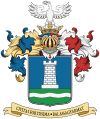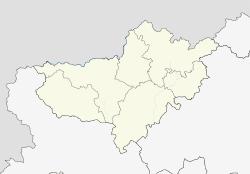Balassagyarmat Jahrmarkt (in German) Balašske Ďarmoty (in Slovak) | |
|---|---|
Town | |
 Balassagyarmat County Hall | |
| Nickname(s): Civitas Fortissima (The Bravest City) | |
| Coordinates: 48°04′43″N 19°17′39″E / 48.07861°N 19.29417°E | |
| Country | |
| County | Nógrád |
| District | Balassagyarmat |
| First written mention | 1244 |
| Government | |
| • Mayor | Gábor Csach (Fidesz-KDNP) |
| Area | |
| • Total | 23.33 km2 (9.01 sq mi) |
| Population (2017) | |
| • Total | 15,058[1] |
| Demonym(s) | balassagyarmati |
| Time zone | UTC+1 (CET) |
| • Summer (DST) | UTC+2 (CEST) |
| Postal code | 2660 |
| Area code | (+36) 35 |
| Website | balassagyarmat |
Balassagyarmat (formerly Balassa-Gyarmath, Slovak: Balážske Ďarmoty, German: Jahrmarkt) is a town in northern Hungary. It was the seat of the Nógrád comitatus.
History
Since 1998, the town's coat of arms has borne the Latin inscription "Civitas Fortissima" (the bravest city) because it was claimed that in January 1919 Czechoslovak troops crossed the demarcation line delineated in December 1918 in preparation for the Treaty of Trianon, illegally occupying towns south of the line, including Balassagyarmat.[2] The occupation was the subject of a 2009 song by the nationalist rock-band Kárpátia, "Civitas Fortissima"[3]
During World War II, May 9, 1944, Germans kept 3,000 Jews from the town and the surrounding villages imprisoned in a ghetto. They were all sent to Auschwitz concentration camp on June 11 and 14, 1944.[4]
Balassagyarmat was captured on 9 December 1944 by Soviet troops of the 2nd Ukrainian Front in the course of the Budapest Offensive.
Geography
The town lies on the left bank of the Ipoly river, which marks the state border with Slovakia.
Demographics
In 2001 Balassagyarmat had 18,474 inhabitants. The population were Hungarian 98%, Romani 2%.[5] 100% of the total population speak Hungarian as their mother tongue.
Notable people
- Balassi (Balassa) family (means "from Balassa")
- Bálint Balassi (aka Balassa) (1554, Zólyom - 1594)
- Josef Dobrovský (1753–1829), a Czech philologist and historian
- Márk Rózsavölgyi (1789–1848), musician, componist
- Maier Zipser (1815–1869), neolog rabbi
- Kálmán Mikszáth (1847-1910), Hungarian novelist, journalist, and politician, lived here
- Károly Balogh de Mankó Bük (1879-1944), Hungarian statesman and writer.
- Iván Nagy (hu) (1824–1898), genealogist, heraldic, historian
- János Zádori (1831-1887), Roman Catholic priest, Ecclesiastical writer, lived here
- Sigmund Streisinger (1880-1942), glazer
- Dezső Magos (Munk) (1884-1944), Hungarian architect
- Albert Kenessey surgeon (1889–1973)
- Rose & Jenny Dolly, Hungarian-American dancers and actresses
- Lőrinc Szabó (de Gáborján) (1900-1957), a poet and literary translator, lived here
- Lajos Ligeti (hu) (1902–1987), orientalist
- Michel Gyarmathy, director of Folies Bergère in Paris
- Ernő Zórád (hu) (1911–2004), illustrator, graphic artist, painter, comic artist
- Károly Jobbágy (hu) (1921–1998), poet and literary translator
- Iván Markó (hu) (born 1947), ballet dancer, choreographer
- György Udvardy (born 1960), Roman Catholic Archbishop of Veszprém
- Ferenc Palánki (hu) (born 1964), Roman Catholic Bishop of Debrecen-Nyíregyháza
- Zoltán Szlezák (born 1967), football player
- Péter Kőszeghy (born 1971), composer and music educator
- Orsolya Szatmári (hu) (born 1975), pop singer
International relations
Twin towns — Sister cities
Balassagyarmat is twinned with:
 Romania Dej
Romania Dej Germany Heimenkirch
Germany Heimenkirch Poland Ostrołęka
Poland Ostrołęka Italy Lamezia Terme
Italy Lamezia Terme Slovakia Slovenské Ďarmoty
Slovakia Slovenské Ďarmoty
See also
- Slovenské Ďarmoty
- Salesians in Hungary
- Balassa
- Prison of Balassagyarmat (hu)
- Lutheran Church of Balassagyarmat (hu)
- Palóc Museum (hu)
- Public transport of Balassagyarmat (hu)
External links
- Official site in Hungarian
References
- ^ Balassagyarmat, KSH
- ^ Hungarian foreign policy: Fidesz or Duchy of Fenwick style? http://hungarianspectrum.org/2009/09/09/hungarian-foreign-policy-fidesz-style/
- ^ "Archived copy". Archived from the original on 2009-09-18. Retrieved 2009-09-15.
- ^ http://www.yadvashem.org/yv/he/research/ghettos_encyclopedia/ghetto_details.asp?cid=149
- ^ Hungarian census 2001



